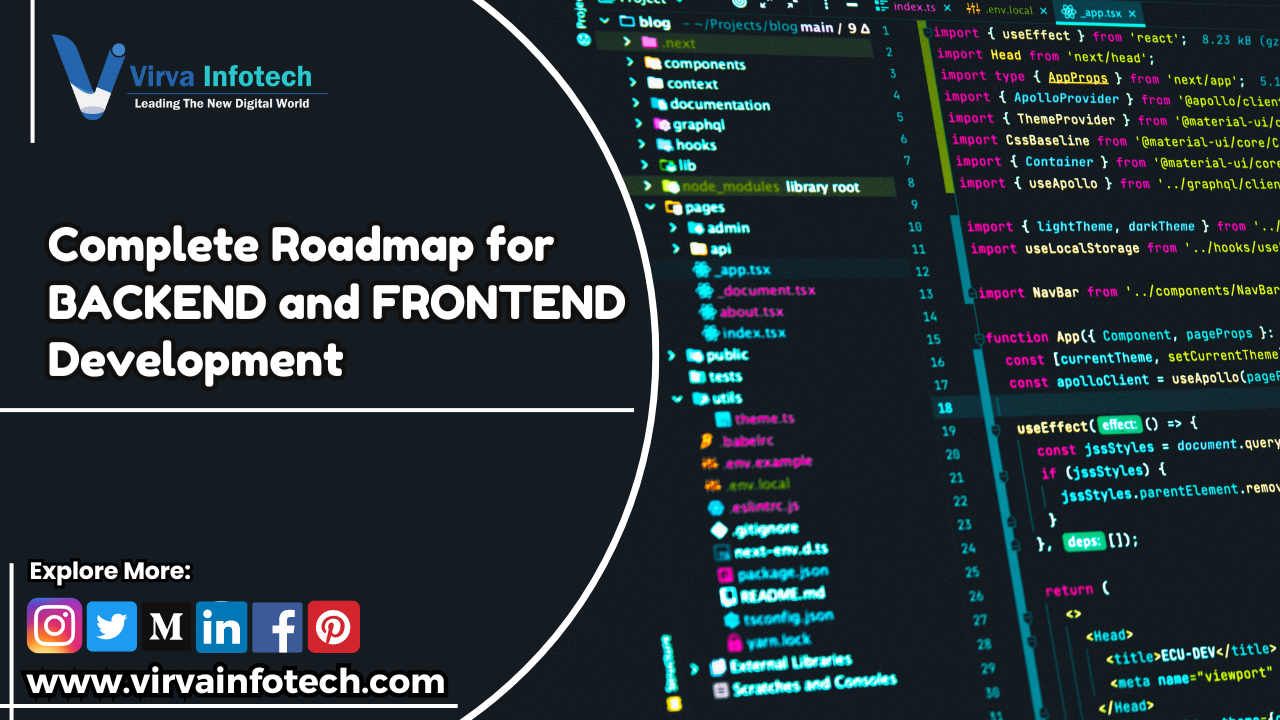Posted At: Aug 24, 2024 - 209 Views

1. Complete Roadmap for Frontend Development
So, you're interested in becoming a frontend developer? Awesome! Let’s face it.
Frontend development is both fun and a little overwhelming at first. But don’t worry; with a solid and proven roadmap with some patience, you’ll be building cool websites and apps in no time. Here's your guide to get you from zero to hero in frontend coding.
1. Start with the Basics: HTML & CSS
Before you can get fancy with all the frameworks and libraries, you need to master the basics. Think of HTML as the bones of a webpage and CSS as the skin that makes it look beautiful.
>HTML: Learn to structure your content with tags like <div>, <p>, and <img>. It’s not just about adding text; HTML is your go-to tool for creating buttons, forms, and layouts.
>CSS: This is where you start getting creative.Learn how to style text, adjust layouts with Flexbox and Grid, and make your websites responsive for mobile devices.
You don't need to become a Picasso of CSS right away, but understanding these basics will set you up for the more advanced stuff.
2. Dive into JavaScript
Once you're comfortable with HTML and CSS, it’s time to add some interactivity to your sites. JavaScript (JS) is where things start to get interesting.
>Fundamentals: Learn about variables, loops, and functions.Get familiar with DOM manipulation, event listeners, and making API requests.
>ES6+ Syntax: The modern JavaScript syntax is cleaner and more powerful, so focus on mastering concepts like arrow functions, promises, and async/await.
JS will be your bread and butter for adding dynamic functionality like form validation, animations, and interactivity.
3. Get Familiar with Version Control (Git & GitHub)
Even if you’re coding solo, learning Git will help you track your changes and collaborate more effectively when you’re ready to work with others. GitHub is where developers store and share their code. If you plan on contributing to open-source projects, this is essential.
4. Learn a JavaScript Framework: React, Vue, or Angular
Now that you’ve got JavaScript down, it’s time to level up with a framework. This is where frontend development gets spicy.
>React: If you like flexibility, React will be your friend. It’s backed by Facebook and has a massive community. React uses components, making it easier to build reusable, maintainable code.
>Vue: Vue is lightweight and easier to learn for beginners. It's a great choice if you’re building a small to medium-sized project.
>Angular: This is a full-fledged framework with a lot of built-in tools and structure. It’s ideal for large-scale applications, but it has a steeper learning curve.
Pick one (React is a solid choice), and get comfortable building apps with it.
Wanna explore more in details:
1. JavaScript Essentials: Fundamental of JavaScript
2.How does JS Works? Best Resources & References
5. Master Responsive Design
With most web traffic coming from mobile devices, you need to ensure your websites look good on all screen sizes. Learn how to use:
Media Queries: CSS rules that apply to different screen sizes.
>Flexbox & CSS Grid: These tools help you create responsive layouts without needing to rely on frameworks like Bootstrap.
>Responsive Images & Videos: Make sure your media scales properly on different devices.
6. Understand Browser DevTools
Every developer makes mistakes—so learning how to debug your code is critical. Chrome and Firefox both have great developer tools built in. Get comfortable inspecting elements, checking network requests, and debugging JavaScript issues.
7. Strengthen Your Knowledge of Web Performance
As you build more complex projects, performance will become crucial. Understand how to:
>Optimize images and code.
>Lazy-load assets.
>Minify CSS and JavaScript.
>Learn about caching and Content Delivery Networks (CDNs).
Google rewards websites that load fast and work well on mobile, so keep performance in mind
8. Explore CSS Frameworks & Preprocessors
Once you’re comfortable with basic CSS, you can speed up your workflow with frameworks and preprocessors.
>Tailwind CSS: Utility-first CSS framework that gives you a lot of control over your styling.
>Bootstrap: A popular CSS framework for responsive, mobile-first projects.
>Sass: A CSS preprocessor that allows for variables, nested rules, and more powerful styling options.
These tools can help streamline your workflow and make your code more efficient.
9. Build Real Projects
Now that you’ve gained a wide range of skills, the best way to solidify your knowledge is to build, build, build! Start with smaller projects like a portfolio site, a weather app, or a to-do list. As you grow, work on more complex applications like an e-commerce site or a social media dashboard. Real-world projects will teach you how to solve problems, implement features, and write clean, maintainable code.
10. Keep Learning & Stay Updated
The world of frontend development changes rapidly. Stay up to date and consistent by following blogs, joining communities, and experimenting with new tools and frameworks. Here are a few great resources:
>MDN Web Docs: For reference and learning web standards.
>FreeCodeCamp& Codecademy: Interactive tutorials for all levels.
>Frontend Mentor: Real-life challenges to sharpen your skills.
>Udemy: Find best mentor and courses online
>Javatpointand w3school: Full package with complete notes.
>>Generally, becoming a frontend developer takes time and dedication, but it’s also a lot of fun. By following this roadmap, you’ll have a clear path to becoming a capable, confident developer. The key is to keep learning, stay curious, and don’t be afraid to break things and experiment. After all, that’s how you’ll grow.
2. Complete Roadmap for Backend Development: Become a Backend Pro
Backend development is whole behind the scenes. It’s the core and engine powering the web and mobile applications that users interact with every day. Whether it’s processing data, handling user authentication, or communicating with databases, backend development is a crucial part of any modern application.
1. Understand the Basics of Backend Development
Before diving into the tech, it’s essential to understand what backend development is all about.
What is Backend Development? Unlike frontend, which focuses on what users see, backend development involves building the server, databases, and application logic that powers your app. This is where data is processed, stored, and retrieved.
Languages & Frameworks: There are several programming languages and frameworks to choose from, including:
>JavaScript/Node.js
>Python/Django or Flask
>Ruby on Rails
>Java/Spring
>PHP/Laravel
Pick one language and framework that aligns with your goals. Node.js and Python are popular choices due to their flexibility and extensive community support.
2. Learn a Programming Language
Choosing the right programming languageis the first step. Let’s take a closer look at some popular options:
>Node.js (JavaScript): If you’re coming from a frontend JavaScript background, Node.js might be the easiest to learn. It allows you to use JavaScript on the server side, which is excellent for full-stack development.
>Python: Widely loved for its simplicity and readability, Python is often used in backend development with frameworks like Django and Flask.
>Ruby on Rails: Known for its ease of use, Ruby on Rails is excellent for quickly building applications.
>Java: A strong contender in enterprise-level applications, Java and its Spring framework are robust and secure choices.
Start with basic syntax, learn how to write functions, control flow, and object-oriented programming principles.
3. Master the Command Line
The command line is an essential tool for every backend developer. You’ll use it to navigate your file system, manage servers, and work with version control. Mastering basic commands will save you time and make you more productive.
>Learn commands to navigate files and directories.
>Understand how to use package managers like npm (for Node.js) or pip (for Python).
>Familiarize yourself with basic shell scripting to automate repetitive tasks.
4. Dive Into Databases
Databases are the backbone of backend development. You’ll need to understand how to store, manage, and retrieve data. There are two main types of databases you’ll work with:
>Relational Databases (SQL): Examples include MySQL, PostgreSQL, and SQLite. SQL databases use structured tables and relationships to store data, and you’ll need to learn SQL (Structured Query Language) to query the database.
>NoSQL Databases: Examples include MongoDB and Firebase. NoSQL databases store data in a more flexible format, like JSON documents.
Start with SQL databases, as they’re commonly used in most applications. Learn how to create tables, write queries, and optimize database performance.
5. Understand Server and Hosting Basics
Once you have a grasp of coding and databases, the next step is to learn how to deploy your applications on a server.
>Servers: Understand the role of a server in backend development. Learn about handling HTTP requests, routing, and building RESTful APIs.
>Hosting Providers: Popular hosting providers like AWS, DigitalOcean, and Heroku allow you to deploy your applications to the cloud. Get familiar with their basic services.
>Linux Fundamentals: Most servers run on Linux, so learning basic Linux commands and server administration will help you manage your deployments.
6. Learn about APIs and RESTful Services
APIs (Application Programming Interfaces) allow different services to communicate with each other. As a backend developer, building APIs is a crucial part of your job.
>RESTful APIs: REST (Representational State Transfer) is a popular architecture style for building APIs. Learn how to create endpoints that handle different HTTP requests (GET, POST, PUT, DELETE) and respond with JSON data.
>Authentication: Understand how to implement secure authentication using methods like JWT (JSON Web Tokens) or OAuth.
Once you master REST APIs, you can also explore GraphQL, a newer technology that offers more flexibility in querying data.
7. Get Comfortable with Version Control (Git & GitHub)
Just like with frontend development, Git is essential in backend development. It helps you keep track of changes, collaborate with others, and revert to previous versions if something goes wrong.
>Git Basics: Learn how to clone repositories, make commits, create branches, and merge code.
>GitHub/GitLab: These platforms host your code and make collaboration easier, especially if you’re working in teams.
8. Explore Caching and Message Brokers
As your backend skills grow, you’ll want to optimize your applications for performance. Two critical concepts in this space are caching and message brokers:
>Caching: Learn about in-memory data stores like Redis or Memcached that can help you speed up your application by storing frequently accessed data temporarily.
>Message Brokers: Systems like RabbitMQ or Apache Kafka allow your application to handle background jobs and communication between services more efficiently.
9. Focus on Security
Security is crucial in backend development since you’re handling sensitive data like user information and passwords.
>Encryption: Understand how to encrypt data both in transit and at rest.
>SSL/TLS: Learn about securing HTTP connections using SSL certificates.
>Vulnerabilities: Be aware of common security threats like SQL injection, cross-site scripting (XSS), and cross-site request forgery (CSRF). Know how to protect your applications from these attacks.
10. Build Real Projects
Now it’s time to put your knowledge to the test. Start building projects that solve real-world problems. This could be anything from a simple blog to a fully functional e-commerce site with user authentication, payment processing, and data storage.
Here are some ideas:
>A task manager app with user authentication.
>A blog platform with a database to store posts.
>An API for a mobile app that tracks fitness activities.
These projects will help you apply everything you’ve learned and give you something to show potential employers.
11. Keep Learning
Backend development is an ever-evolving field, and you’ll need to stay updated with the latest technologies and best practices. Follow blogs, join communities, and continue building projects.
Here are a few resources:
>Stack Overflow and Reddit: Great for finding answers to specific problems.
>UdemyandCoursera: Offer excellent courses for deep-diving into specific backend topics.
>Official Documentation: Always refer to the official documentation for the frameworks and libraries you’re using.
Final thoughts;
Learning backend development can seem daunting at first, but with a clear roadmap, you’ll find it manageable and rewarding. By following the steps in this guide, you’ll gradually gain the knowledge and skills needed to build powerful, secure, and scalable backend systems. Take it one step at a time, practice consistently, and don’t be afraid to tackle new challenges. Backend development is the backbone of modern applications, master it, and you’ll have the power to build anything you can imagine.
It dosen't matter whether that is backend or frontend. The only thing which is the key for mastering both is; Practice, Practice, Practice and Practice.
Good luck on your coding journey Fellows!


